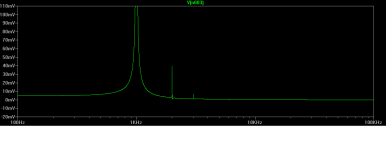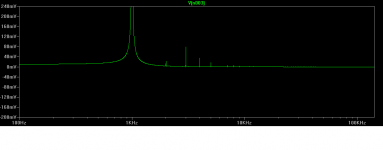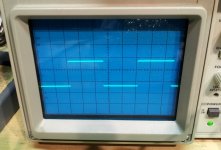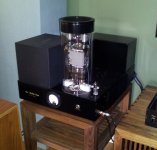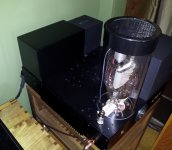I didn't do any distortion measurements on the amps yet, and honestly, I'm enjoying them far too much to bother right now. Maybe when I get bored.
However, I did simulate the amp in LTSpice. Below are the FFT results at 38W (just before the onset of A2 operation) and at 84W (well into A2). At 38W I get about 0.45% second harmonic and less third. At 84W I get about .76% third harmonic.
However, I did simulate the amp in LTSpice. Below are the FFT results at 38W (just before the onset of A2 operation) and at 84W (well into A2). At 38W I get about 0.45% second harmonic and less third. At 84W I get about .76% third harmonic.
Attachments
Wow, 2KHz and you get that? Pretty dire...
OK, I was trying to be nice and answer your questions in a constructive manner, but you can't help yourself but be a troll, can you?
I should have known better than to feed you. Have a nice life.
The roll-off is very sharp for the monolith transformer and only till -12dB we can see at the datasheet. Maybe there are some, at very high frequencies, resonance problems.
http://www.monolithmagnetics.com/im...33 single ended output transformer prelim.pdf
Here a brand X transformer with little resonance problem: (scale 5dB/div)
and the squarewave respons 1kHz:
and 10kHz:
http://www.monolithmagnetics.com/im...33 single ended output transformer prelim.pdf
Here a brand X transformer with little resonance problem: (scale 5dB/div)
An externally hosted image should be here but it was not working when we last tested it.
and the squarewave respons 1kHz:
An externally hosted image should be here but it was not working when we last tested it.
and 10kHz:
An externally hosted image should be here but it was not working when we last tested it.
Last edited:
Monty,
Find someplace else to troll with your inane opinions and comments. You clearly lack the ability to build anything like what Magz has done and also VERY CLEARLY have limited knowledge in this arena. There is far more to good sounding hifi than scope shots and distortion figures.
If you don't like what is presented here, go listen to your Ipod and MP3's as I'm sure they sound great to you.
I'm certain this is your idea of good hifi and it likely measures better than most tube amps:
http://www.bestbuy.com/site/gogroove-sonaverse-7-w-home-audio-speaker-system-ipod-supported/1308760252.p?id=mp1308760252&skuId=1308760252&st=categoryid$abcat0203000&cp=1&lp=12#tab=buyingOptions
Once you actually learn what makes decent hifi, and have an honest quest for knowledge, then come on back and share what you think you've learned. Until then, go troll someplace else little man.
Steve
Find someplace else to troll with your inane opinions and comments. You clearly lack the ability to build anything like what Magz has done and also VERY CLEARLY have limited knowledge in this arena. There is far more to good sounding hifi than scope shots and distortion figures.
If you don't like what is presented here, go listen to your Ipod and MP3's as I'm sure they sound great to you.
I'm certain this is your idea of good hifi and it likely measures better than most tube amps:
http://www.bestbuy.com/site/gogroove-sonaverse-7-w-home-audio-speaker-system-ipod-supported/1308760252.p?id=mp1308760252&skuId=1308760252&st=categoryid$abcat0203000&cp=1&lp=12#tab=buyingOptions
Once you actually learn what makes decent hifi, and have an honest quest for knowledge, then come on back and share what you think you've learned. Until then, go troll someplace else little man.
Steve
Last edited:
OK, I managed to get over the "Youtube Crisis" by downloading the video from my phone to my PC, then uploading from there. Enjoy!
https://www.youtube.com/watch?v=3_cAERyP4_8
PS: Sorry about the grumpiness...I hate it when technology doesn't work!
Thanks for the video!
I remember going to a Frank Sinatra concert back in the 1980's. It brought back some good memories.
The roll-off is very sharp for the monolith transformer and only till -12dB we can see at the datasheet. Maybe there are some, at very high frequencies, resonance problems.
Perhaps. I know it's coming from the output stage because the square wave from the driver stage to the 833 grid is perfect (see below). I intended to address the overshoot but my listening has convinced me it's not a problem. Funny thing is, when I had a similar but slightly larger overshoot in my DIY preamp, it was clearly audible in the HF and quite fatiguing. When I damped it out with an RC network and some series resistance on the input transformer the sound was remarkably better.
I think there must be an effect from intermodulation of the disturbance with the signal as it travels through the preamp, amp driver stage and amp finals that causes an overshoot to be so offensive when it originates in the preamp input yet be inaudible when it comes from the amp OPT.
Attachments
Last edited:
and the squarewave respons 1kHz:
An externally hosted image should be here but it was not working when we last tested it.
A little bit of a slope on the tops and bottoms of the square wave, indicating a little LF rolloff?
The price I pay for the ruler flat square wave and thunderous bass response in a high ratio OPT is an increase in parasitics, so that's very likely where the overshoot comes from. If I can't hear it, I don't worry about it...aesthetically unpleasing scope shots aside.
Today's discussion reminds me to repeat my invitation to those DIYers anywhere near the central NJ area to stop by and hear my "non-Hifi" amps for themselves.
Just drop me a PM and we'll set up some time. I'm pretty much addicted to them so spending some more time listening is not a burden at all!
Just drop me a PM and we'll set up some time. I'm pretty much addicted to them so spending some more time listening is not a burden at all!
I know the problem with the esl-transformers i make. I do that with a reason, the capacity of the esl-unit and the impedance i want for my amp. Damping with a serie resistor works, but adds more distortion.
All can be different with you loudspeaker so don't worry to much about it.
All can be different with you loudspeaker so don't worry to much about it.
Perhaps. I know it's coming from the output stage because the square wave from the driver stage to the 833 grid is perfect (see below). I intended to address the overshoot but my listening has convinced me it's not a problem. Funny thing is, when I had a similar but slightly larger overshoot in my DIY preamp, it was clearly audible in the HF and quite fatiguing. When I damped it out with an RC network and some series resistance on the input transformer the sound was remarkably better.
I think there must be an effect from intermodulation of the disturbance with the signal as it travels through the preamp, amp driver stage and amp finals that causes an overshoot to be so offensive when it originates in the preamp input yet be inaudible when it comes from the amp OPT.
I'm actually studying electronic engineering so I don't have much space to carry stuff around
I have been recently "retired" from my 41 year career as an advanced development engineer. I am in the process of moving all my equipment, including my lab. All my tube amps are packed up, so I am currently listening to a tiny silicon chip.
It is a test board furnished by TI for evaluation of a class D amp. Complete test data was furnished by TI, and verified by the audio lab where I worked. The distortion is below 0.1% for all audio frequencies, at power levels below 10 WPC. I stuck this board in place of my 8 year old SSE SET amp which makes 8 WPC at clip and the distortion is just under 1% at 1 watt. The same Yamaha NS-10M Studio monitors (nothing below 75Hz) and cheap powered sub, were used.
I must admit that the 2 inch PC board sounded far better than I expected, but for most music I would rather listen to my SSE, distortion and all. The little chip excels with bass heavy dynamic music, probably due to its near zero output impedance.
Basically what you're saying is 'I heard it, mah ears think it's better, that settles it'. Pretty primitive approach if you ask me...
No, what I do is measure EVERYTHING 26 ways from Sunday during the design and development process, then listen, tweak, measure some more.....repeat. Then I drag the amp to my friends places to hear it on other speakers, and with other peoples ears.....then repeat the whole process until I can't make it any better. The consensus is that best sound, and lowest measured distortion don't always coincide.
I have been designing and building amps for about 50 years, tube, solid state, and chip amp in power levels from a few milliwatts to 1200 watts, for HiFi and musical instrument, and RF power up to 2.5 GHz. After you have been at it for a while, you come to realize that specs may sell the product, but aren't the only thing that's important.
Looking for lost keys under the streetlamp
The general theory that THD is not particularly useful as a figure of merit has been around for a very long time.
Finally someone (Geddes and Lee) has attempted to define a better metric and their initial research showed a much higher correlation between this figure of merit and perceived sound quality.
The maths is a little ugly but not impossibly so - at least for a reasonable approximation
.... After you have been at it for a while, you come to realize that specs may sell the product, but aren't the only thing that's important.
The general theory that THD is not particularly useful as a figure of merit has been around for a very long time.
Finally someone (Geddes and Lee) has attempted to define a better metric and their initial research showed a much higher correlation between this figure of merit and perceived sound quality.
The maths is a little ugly but not impossibly so - at least for a reasonable approximation
Yes, the LF is less good as the MM transformer, 12Hz -3dB instead of 8Hz.
A little bit of a slope on the tops and bottoms of the square wave, indicating a little LF rolloff?
The price I pay for the ruler flat square wave and thunderous bass response in a high ratio OPT is an increase in parasitics, so that's very likely where the overshoot comes from. If I can't hear it, I don't worry about it...aesthetically unpleasing scope shots aside.
I was a little bit unhappy with the appearance of the Hammond 733A transformers, with the lumpy, uneven black spray paint job they came with, so I had a pair of aluminum covers welded up and then had them powder coated satin black (see pictures). They cover both the 733A and the 369KX transformers and give each mono a more finished look, I think.
Attachments
Love the 6E5P - I bought 50 of them so I don't run out.
Funny thing is, the Monolith OPT and choke are actually black, a black metallic that in normal light looks pretty close to the new covers in color. Whenever I take a picture, though, the metallic particles seem to catch the light and make them look grey...they're most definitely not.
Funny thing is, the Monolith OPT and choke are actually black, a black metallic that in normal light looks pretty close to the new covers in color. Whenever I take a picture, though, the metallic particles seem to catch the light and make them look grey...they're most definitely not.
Funny thing is, the Monolith OPT and choke are actually black, a black metallic that in normal light looks pretty close to the new covers in color. Whenever I take a picture, though, the metallic particles seem to catch the light and make them look grey...they're most definitely not.
I guess the best description would be charcoal black for the Monolith coating color in typical room light.
Indeed, 6E5P are well worth stocking up on. Shhh, the secrets out. Lol.
I managed to make my scope expire testing a driver using them last week. Had to be the only part that is virtually unobtainable here. Tektronix scopes are a side shoot of this hobby but they reach an age when parts become rare. Funny thing is as they age past that, parts are easy to find.
Photography is alien to me. It is a skilled job to get right. I think your photos look great.
Cheers
Matt.
I managed to make my scope expire testing a driver using them last week. Had to be the only part that is virtually unobtainable here. Tektronix scopes are a side shoot of this hobby but they reach an age when parts become rare. Funny thing is as they age past that, parts are easy to find.
Photography is alien to me. It is a skilled job to get right. I think your photos look great.
Cheers
Matt.
- Home
- Amplifiers
- Tubes / Valves
- The Midlife Crisis - My 833C Amp Build
